Sagadahoc Stories #85: 3/29/99
Parts List
| Signs and portents continue. Mr. Mann reports that turkey love
commenced the first day of Spring, right on schedule. The big
tom that's been tending his harem at the feeder behind the Mann
house blushed his wattles on the equinox, and fanned his tail
at the hens. They got all excited, neck bobbed and gabbled enthusiastic,
then paraded after him into the woods. |
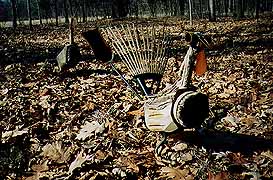
Kay Gray Photo
|
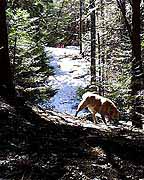
|
I followed CC into the puckerbrush one midday, sporting my yellow
rubber boots and a pair of shades, looking for some seasonal excitement
myself. The surface frost has turned to mush where the sun has
touched it, but down in the hollows you still crunch through frozen
crust, sideslide the slopes, and tip-toe over ice bridges in the
swamps. A splay-legged hobble with your ass hung low is the only
way to stay upright. Spring Shuffle in the Maine woods. |
| Rain and sun have dissolved the snow under the trees, but out
on the trails, where it lay deeper and more compacted, granular
masses of old winter still swallow your boots. You can see white
highways winding through the dark distance between the trees.
A new woods landscape where contrast is the subject, and old duff
the dominant tone. |
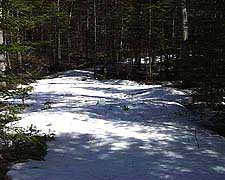
|
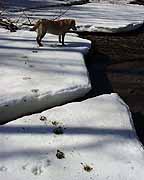
|
The last persistent beech leaves ocre and rattle the air, waiting
for new buds to unhinge them. The rest of us are pretty unhinged
already. A few days in the 40s and us seasonal shut-ins are out
kicking the ice clumps, setting small fires, and otherwise celebrating.
Every surface is wonderfully dirty. Old bog ice is coated in silt,
dead leaves have a gritty rind, all the detritus of winter lies
scattered on top. You realize how old settlements can disappear
under layers of dirt in a few years. CC was in glory up to her
ears. |
| We rousted out Mr. Mann who was finicking over his romantic study
of Barbie and the Crash Test Dummy. I'm constantly astonished
at how David can labor on a watercolor for weeks, lifting and
washing, pushing depths in and pulling forms out. If I belabor
a watercolor it turns to muck immediately, but he can polish it
to a glow. This still-life is one of his current projects, and
I was delighted to see that he was using stills on a video monitor
to work from, in addition to the actual objects. The VCR image
captures the light of a particular instant, and lets him zoom
in on details. How apt for Barbie to be studied via video. |
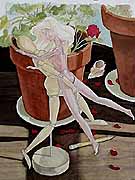
Barbie with Dummy
|
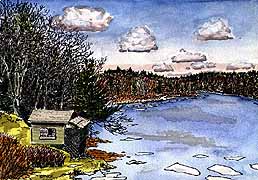
River Ice
|
CC led us down to the river, and leaped from beached flow to flow.
We didn't join her for a ritual immersion, and tried to dodge
her shaking it off. The tide was still wheeling loose cakes and
pans upriver, and the marginal flats had rows of fractured white
trimming the scene. Close up, the trees looked dormant, but a
wide-angle view showed the maples and oaks tinged red with buds.
You might call a painting of late March "Bleached Beige and Buds." |
When CC and I got home, my blood was up, and I started pacing
out where this boat is going to arise. A sudden cry startled the
air above me. A haunting musical note. Half honk, half scream.
Ducking and twisting my neck, there was a pair of courting eagles
cavorting over my head, tumbling through an aerobatic arabesque.
In a flurry of wingbeats they were gone and I was breathless with
joy. That eldritch call, the great beating of wings, and the immensity
of the birds close up. Magic. Initiation fit for an ark.
|
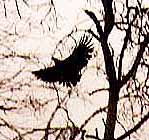
|
With that motivation I began the boatbuilding process in earnest,
which means making a host of small decisions. Although the basic
hull shape of this vessel is clear, a curvilinear box, I have
to come to some understanding of the construction details before
I can gather materials. Building a boat is both like and unlike
conjuring a sculpture. Instead of marshaling images of subjects
and animals, then making a rough sketch, I steep myself in boat
plans and photos, then pencil out a crude set of lines on graph
paper. Both creations start with envisioning, but where one form
mutates with the materials and evolves as the image is realized,
the other is built on a rigid skeleton, and the essential expression
is defined before the first timber is bent.
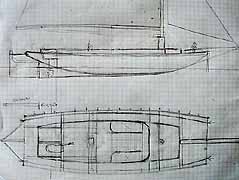
Right now there's a bunch of conundra to untangle. How will she
be sparred and rigged? What kind of rudder? How steered? How will
I mount the outboard? Centerboard or lee-boards? Full length skeg?
Stowage and hatches? Sun shelter and a swim ladder for Peggy?
Seating? Some of these determinations will affect basic framing
and hull construction. Others are superficial details, but it's
better to thrash out as much as you can before you start setting
up, lest you overlook a crucial ingredient. This is seat of the
pants marine architecture, so I have to put a sheen on my britches
first.
But there's the timing factor, too. If this baby is going to splash
in before the sun gets too high, I have to line up my materials
so they're handy when I need them. For starters I need a strongback
to build on and one-by to puzzle molds out of. Then I'll need
frame stock, and planking, and fasteners. Capt. Ken has been a
great source of practical advice, even though he thinks I'm nuts
to be building a scow, while the boys at the restaurant have been
egging me on, and debating details. But at some point I have to
fix on a plan and get wheels turning.
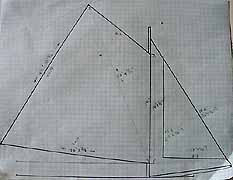
In the end I came down to two closely related hull shapes, both
recorded by Howard Chapelle, the great marine historian, in the
1930s. One, constructed by a builder from Bath, has finer lines
than the other, taken off a hulk in Freeport, of unknown provenance.
The first looks sweeter to my eye, but I'm wary of that instinct.
When I built Sharpie I stretched her molds to make her look finer
to me, and run faster under power, but it resulted in a very tender
sailer. This time I intend to spread a lot more canvas in proportion
to her hull size, and I'm leery of making her too lean. The fatter
boat would be 8 foot at the beam and 24 long. The lean one would
be nearer 6 in a 24. I measured up enough materials for the beamier
beast, just in case.
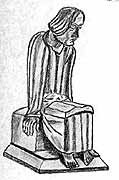
Reader (After Barlach)
|
Measuring old plans, converting to the size you want, figuring
up scantlings and fastenings is nervous work for me, as I'm constitutionally
innumerate. I don't count so good, either. I made a rough calc,
though, and went shopping.
|
First stop was at Morse's mill in Winnegance. Doing all this reading
about the history of the Sagadahoc it felt right to be smelling
fresh-sawn lumber down along the Kennebec, where they've been
playing this game for 300+ years. You get disabused of your romanticism
real quick at Morse's, though. Wander in with a scribbled parts
list and a bit of uncertainty and you'll get a tongue-lashing
for being an irritating nuisance.
|
I'd done business there before, however, and expected to be embarrassed
about my ignorance as part of the routine. Good to be reminded
you don't know diddly. After Morse decided to bother with me,
we eyeballed some oak logs. He asked, "Red or white?" and I said
I'd always like white if I could get it, and asked if it wasn't
a bad idea to mix the two.
"I don't know as it makes a difference," he grumbled.
|
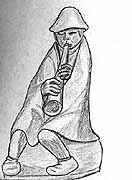
Diddly (After Barlach)
|
Fact is, Fowler once showed me how you can blow smoke through
a length of red oak, because of its open pores, while you can't
with white. Which may help explain why the red oak in Sharpie
went punky so soon. But I wasn't about to make demands at Morse's.
If he wanted to saw white oak for me, he would, and otherwise
I was just blowing smoke. Morse took me around the end of a pile
and pointed out a stick of white oak, which had a lovely twitch
in the end that would suit the skeg to perfection. I said so,
and he grunted.
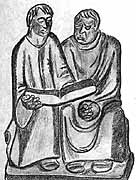
Monks (After Barlach)
|
We sat on a pile of lumber and he sketched on a board, asked me
about construction details, copied my parts list onto a slip of
paper.
"When do you want this?"
"At your convenience. I hope to be setting molds by the first."
"Well, maybe next week. I've got a delivery up your way anyhow." |
I didn't even think to ask about price, but I know it'll be the
going rate, and the measure will be just right. I could have gotten
oak up here, but it would be red, and without the twitch. So I've
ordered framing in Winnegance. Five-quarter live edge, two-sided
to one inch, and finished four inch for the skeg and bowsprit.
Saturday awoke mild and sunny, and the whole town spilled out
into the Springshine. Harvey came up and helped me get Ebba running.
He deduced a weak spark and maybe a soft accelerator pump in the
carb, but she fired when he advanced the spark, and I managed
to keep her awake all day. He went up to Messers and got a distributor
with an electronic ignition on it to try and boost the juice,
but we didn't get it cleaned and installed before dark, so much
was going on.
|
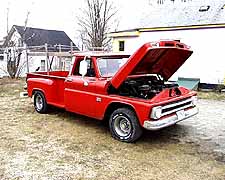
|
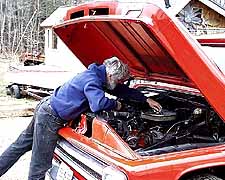
|
I learned that it's hard to change you automotive habits. All
those slant six Chryslers I rodded around in could be goosed into
life by pumping the throttle vigorously, so I tend to work the
gas like mad when cranking a cold beast. With the big 4-barrel
on this 283 a little pumping goes a long way. Too far, in fact.
She'll start without any goosing, if at all. My ankle was shaking
with anticipation each time I started her Saturday, and I had
to talk to it like an eager pup. Maybe I'll learn to be a Chevyite
yet. |
| I ran into Eric the woodman at the gas station. He was just finishing
a logging trick and said he'd be home at the mill later in the
afternoon, so I rolled the red lady out the Millay Road and down
201 as the sun declined. When I got there one of the Temples was
yarning in the yard, and I got an extended run-down on the old
buildings in town and their confused ownership, new insurance
requirements for the Knights of Pythias Hall, and the history
of local fire engines. The fire department has two old hand pumpers
stored away, and they've been talking about asking me to do paintings
of them, he said. I said I'd be delighted. Apparently the old
Phoenix is one of only two still in existence. He told me when
he was a boy the department used to take the other one to musters
and compete against teams from all over the state. The crew from
Rockland trained like athletes for the musters, and always took
home the pumping prizes. |
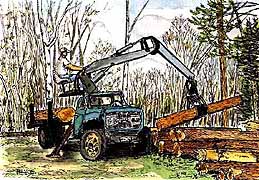
Pulp Loader
|
I took home a truckload of 6X6s and 1X4s for a strongback and
molds, and made an arrangement to pick over some clear pine to
run through Eric's planer to make plank this week. Looks like
I've got my lumber lined up. I may have found a name, too. In
a history of Bath written in 1842 I read that the Indians called
Merrymeeting Bay "QUABACOOK". Maybe a good name for this square-toed
frigate who'll dance on the Bay.
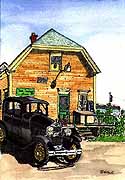
Model A
|
Spring fever has everyone turned upside down. They closed the
Town Landing for four days this week to start building an apartment
into the big lumber room upstairs, and do spring cleaning in the
restaurant. It took Jeanine the full rigmarole to get planning
approval for the apartment. Not only was she required to submit
detailed documentation of plans, septic use, flood plain siting,
and letters of OK from the abutters, but she had to endure an
examination before the planning board, who have been hostile to
restaurant renovations in the past. Back when Bruce and Judy ran
the place the board slapped down all the proposed renovations
they asked for. Jeanine isn't quite as hair-trigger as Bruce,
though, and hung in there through the whole charade. |
| You could hardly argue that it isn't a residential area, with
three out of six abutters being residences, and you could hardly
argue increased parking problems with the restaurant parking lots
empty all night. Angie and her man, Eric the artist, are going
to live there as Angie takes over the business. You'd think the
planning board would like to see a vital business thrive, but
Jeanine was asked if "a family" might live there, as if that wasn't
quite proper. |
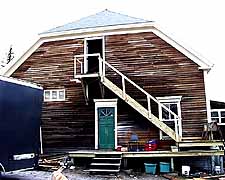
|
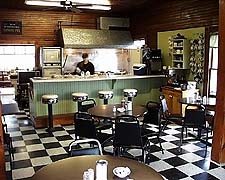
|
She got the go-ahead, anyhow, and now a new suspended floor has
been spliced in upstairs, new tiles have been laid in the restaurant,
and the whole place sparkles. It was mobbed all day and evening
on Friday, after they reopened, and we soaked up a bunch of chowder
in celebration.
|
| It's been a treat to watch the changing of the guard at the Town
Landing. As Jeanine has relinquished day to day management to
Angie, she and Dianne have begun to look more relaxed, taken some
real time off. Angie and Allie, Jeanine's girls, have been running
the day shift Monday to Friday, and keeping the regulars happy,
while mom comes back on the weekend to spell them. After Short-order
Bob handed in his spatula they hired Christine, to wait table,
and now Eric is working the grill as well. What with Allie's little
boy Aaron spinning on the stools, and Eric there for Angie, the
restaurant feels like a home. |
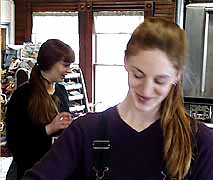
|
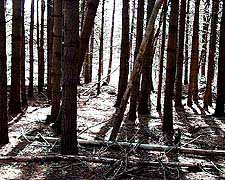
|
Jeanine says it's hard to let go of it. The place has been her
baby for nine years. But she brought it up good, and what could
be better than turning it over to young lovers, in the Spring?
There were jonquils at every table when the doors reopened. |



















